► An in-depth tour of the Museo Storica Alfa Romeo
► Giulia designer and Alfa acolyte Lorenzo Ramaciotti serves as our guide
► Featuring Giulia, 33 Stradale, Alfetta, Disco Volante and Tipo B
It is more or less impossible to maintain a consistent train of thought in the Alfa Romeo museum, a place where each car eclipses the last in endless one-upmanship. Chronology is a noble concept, and a credible enough mechanism with which to try to navigate so much virtuoso art and engineering, but chronology doesn’t legislate for cars like the Pro-Car 164, the geometry of Pininfarina’s front-drive flagship subverted by mile-wide slicks, a brooding ride height and a 620bhp, 3.5-litre F1 V10. Or cars like the 33 Stradale.
The Alfa story began many decades earlier of course, and the first production car is in here, but you find yourself drawn to the 33 Stradale like a moth to an inferno. One of only two mid-engined production cars in Alfa’s back catalogue, the 33 Stradale might claim to be the most beautiful car ever built.
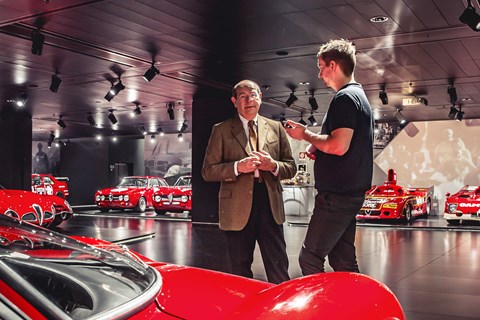
Lorenzo Ramaciotti certainly thinks so. FCA’s recently retired head of design created some of the prettiest production cars in living memory before stepping down (Ferrari 456, Maserati Quattroporte, Ferrari 360, Alfa 4C), but it was the 33 Stradale that inspired him to become a car designer, one enchanted by perfectly proportioned machines alive with curves. Today Ramaciotti will lead me through Alfa Romeo’s spectacular back catalogue with the heart of an aficionado, the mind of an engineer and the hands of an artist. Ah yes, his hands. Quite simply, he can’t keep them off the 33 Stradale.
‘When the 33 Stradale came out, in 1967, the car was seen by enthusiasts – as I was at the time, a student – as belonging to the past because of the roundness, the organic shapes,’ explains Ramaciotti. ‘At the time we were convinced these shapes would be substituted in the fashionable way by something more radical and aggressive, with a unity of surface between the front of the car and the windscreen: a wedge. The midship cars were coming and bringing with them a new paradigm in shape. The Carabo [right] was a manifestation of this. But I prefer the 33 Stradale. The natural shapes have lasted better. You can understand the Carabo if you place it in its time but you could never call it timeless. It is less human, more architectural. It doesn’t look like it was even made to move. This is why I insist on natural surfaces, on muscularity.
‘When you like a surface you want to touch it, to caress it,’ he continues, still fondling the 33. ‘We tried to create this with the new Giulia. The 33 Stradale is very organic, with the feeling of a body. Designed by Franco Scaglione, you notice the extreme roundness of the windshield and the small cabin. We couldn’t do anything quite like this with the Giulia but we were able to have the front wheels at the very front of the car, and to set the cabin towards the rear. This gave us the right balance of proportions from the beginning. Happily this was also the desire of the engineers because they wanted a perfect 50:50 weight distribution.’
Just as the 33 Stradale proved a hugely influential car for Ramaciotti, so it would prove for Alfa Romeo. Underpinned by Alfa’s then new and innovative Tipo 33 racer (H-shaped steel chassis of broad steel tubes with a gorgeous little 2.0-litre V8 tucked behind the pilot), the race car would evolve first into a 3.0-litre V8 (the Targa Florio winning 1970 Tipo 33/3) and then the all-conquering 12-cylinder boxer endurance racers of the mid-1970s, the naturally-aspirated TT 12 (500bhp) and twin-turbo SC 12 Turbo (640bhp), constructors world champions both. That same boxer 12 engine would also see the Alfa name back in F1 for the first time since Farina and Fangio’s reign in ’50 and ’51, in the back of Gordon Murray’s Martini-liveried 1976 Brabham BT-45 (a ’77 BT-45B sits in the museum, as do 158 and 159 Grand Prix Alfettas and myriad Tipo 33s).
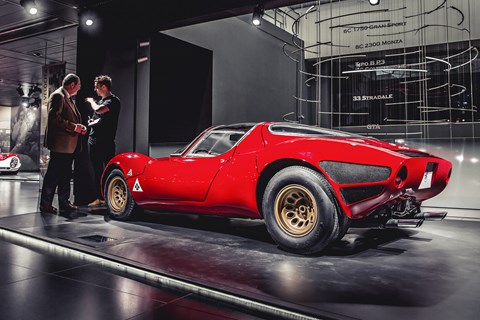
As Tipo 33s cemented the Alfa legend on track, so unused 33 Stradale chassis (18 were built but only 12 blessed with Scaglione’s bodywork and sold) would help make the name synonymous with pioneering design, underpinning a series of outrageous concept cars, the most startling of which was the Carabo, a prime exponent of wedge-shaped futurism. Under lights and surrounded by so much unabashed curvature, the frozen-cucumber-dipped-in-lava Carabo is nothing if not startling, particularly when you consider that its cold geometry was conceived by Bertone’s Marcello Gandini within months of Scaglione’s 33 Stradale.
If the 33 Stradale and Carabo represent marked contrasts in Alfa Romeo design, the vast Grand Prix-engined 1938 8C Lungo and mass-produced Giulietta, presented at the ’54 Turin motor show, read like emphatic punctuation between two eras; between old Alfa, builder of operatic, blood-red Grand Prix cars and luxuriously rapid GTs for the very wealthy, and Alfa Romeo as it is now.
In the 1930s output was fewer than 300 very expensive cars a year. In 1932 the company was sold to the Italian government and in 1935 the military took control. While production temporarily shifted to plane and truck engines, the metamorphosis from Bugatti-esque artisan workshop for the elite to automotive industrial powerhouse had begun. 800 employees in 1930 swelled to 8000 by 1946, and in 1950 came the 1900 family saloon, with its monocoque construction conceived for mass production.
Alfa built 18,000 cars between 1950 and 1958, more than in the previous 40 years combined. That spectacular upward trajectory continued with two key cars: the Giulietta, first in 2+2 two-door Sprint form and then as the neat and compact Berlina saloon (a family car shorter than the current Mito…); and the original Giulia, the low-drag, lightweight 1960s saloon that would establish Alfa’s reputation as purveyors of handsome, lightweight and powerful (alloy twin-cam fours of 1.4 and 1.6 litres) machines with the balance and poise to humble sports cars.
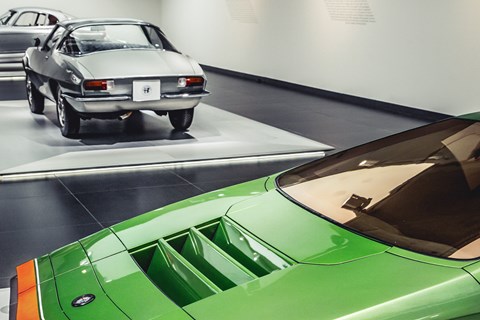
While Ramaciotti enthuses about both machines in their road-going form, it is the necessarily more dramatic competition iterations that really hold him in their thrall. ‘With the 8C 2900 B Lungo there is a fantastic balance between the lightness of the overall car and the solidity of the surfaces,’ he tells me. ‘The surfaces are very rich, which makes the car look solid. A Type 57 Bugatti Atlantic looks fragile by comparison.
‘This is something I like: playing with light rather than resorting to character lines.’ Proponents of lean aesthetic purity come no more compelling than the 8C Lungo’s race-bred stablemate, the Speciale Le Mans. ‘A very advanced design for the time,’ whispers Ramaciotti in reverential tones. ‘It is a pure shape. All the volumes are streamlined and the car itself is essentially one big wing with a teardrop on the top. It is unique, beautiful. And it was so far ahead of the competition.’
The long, narrow and ultra-streamlined Speciale Le Mans was conceived, as the name would suggest, for a single purpose: to use a raging Alfa twin-supercharged straight- eight (in 2926cc guise for 220bhp and a 150mph top speed) in a low-drag body (drag coefficient was just 0.37) to win the 24 Hours of Le Mans. It raced the French classic just4 once, in 1938, and at one point lead by 11 clear laps and nearly 100 miles of racetrack, having set a fastest average lap at 96mph. So small and evidently lightweight as to appear almost fragile, the Speciale nevertheless possesses a kind of baroque menace; the narrow, malevolent gaze of the tank-slit screen, the teardrop cockpit like a fighter plane, the artful cooling slashes in its otherwise unbroken flanks.
It’s a magnetic car, the 8C 2900 B Speciale Le Mans, one from which it takes a good while to drag your gaze, but when we finally do the Giulia TZ 2 is generous recompense. TZ stand for tubolare-Zagato, and the original TZ was a blend of Giulia SS twin-cam power, a then cutting-edge welded spaceframe of tubular steel and jaw-dropping coupe styling from Zagato. The TZ 2 wrought its wicked curves in fibreglass and further refined the TZ’s performance engineering. The very best race cars combine good looks with results and the Giulia TZ 2 was a tool, with class wins at the likes of the Sebring 12 Hours, Nürburgring 1000km, Targa Florio, Le Mans 24 Hours and the Tour de Corse.
‘It is a very small car, tiny, and yet you see in the Giulia TZ 2 some key design elements,’ explains Ramaciotti. ‘Flowing surfaces, the flare in the rear fenders, the very round windshield, the smooth transition around the front of the car into the sides, the wraparound rear screen… It is a racing interpretation of these ideas, with the difference that by this time the Kamm tail had become fashionable and so the rear is much more square. It was called the baby GTO: the proportions and features are the same, and for both cars aerodynamic drag was the same, even though the Alfa was a much smaller car.
‘For its treatment of surfaces this is an inspirational design, along with perhaps my favourite Alfa Romeo of all time, though we do not have one here: the 1964 Canguro concept car, by Giugiaro for Bertone. Very beautiful, with maximum simplicity, it is made only of fine proportions and nice surfacing. I had a Canguro bonnet on the wall in my office at FCA, a reminder of the purity and the simplicity of really good Italian car design. Now I am retired I must find a place for this in my house, which is not easy…’
So many masterpieces, so little time. We pass ranks of front-engined Grand Prix cars before pausing at a curious prototype, the 1940 Tipo 512. ‘A very interesting car, with some advanced features for the time,’ says Ramaciotti. ‘The mid-ship engine, that was already used in the Auto Union, but in this case it’s a flat-12, like you found in the later F1 Ferraris. And it had a De Dion rear axle, a fine solution for the kinematics of the rear, because it was light and it kept the wheels perpendicular to the ground. You see the two-stage supercharger and the fuel tank that is also a seat…’
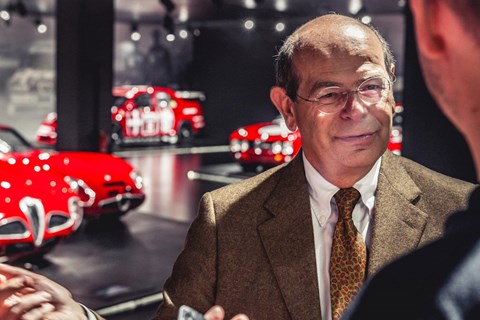
It’s become clear Ramaciotti appreciates the engineering beneath these beautiful bodies. ‘There were no design courses when I trained,’ he tells me. ‘Up until the 1980s designers were self-trained, or they went to architectural or engineering school. I have a degree in mechanical engineering and it helps a great deal. One of the strong points of Italian design is working within the constraints of the layout, not making a nice sketch and then trying to fit it to the package. You can’t achieve success in the proportions that way. You have to conceive the shape on the real car, not on a dream shape that is not feasible.’
For Ramaciotti, Alfa’s modern design language coalesced with the 156 and the 8C. ‘You see here the lineage of cars that express this organic, biological approach to design: sculptural forms with few lines,’ he says. ‘You can see this in the 156: the rounded windshield, the smooth surfaces and a strong interpretation of the Alfa Romeo triangle, not just an add-on to the standard face.
‘This was one of the last Alfas sold in numbers. It embodies very well all that you expect from a modern Alfa, and we have tried to bring this to the Giulia. You can try to bring back a very iconic model, like the 500 or the Beetle, or you can try to build an idea – elements that when put together build a bridge to the cars of the past. I had the chance to do this 15 years ago when I worked on the Quattroporte [2003], the restart of Maserati. We tried to understand which elements made Maserati unique in the market, in the world, and to do something Italian, something with strong proportions and simplicity to stand the test of time.’
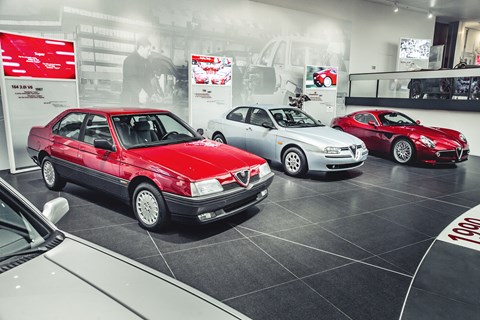
Much has been made of the rapid nature of the new Giulia’s gestation, of how a handpicked team slaved night and day in their skunkworks on this crucial renaissance Alfa. Ramaciotti admits it was an intense project, one fired by enthusiasm and an exhilarating sense of freedom. ‘We didn’t start with a clean sheet of paper on which to write the same story,’ he tells me, ‘but with a clean sheet a paper on which to write a new story. Everything in the car is new but we did not rush. With some things there is a natural timing. There are always four seasons in a year and you need nine months to make a baby. You cannot compress these things beyond a certain point.’
Even when you’re as intimate with Alfa Romeo’s glorious past as Lorenzo Ramaciotti, distilling more than a century of automotive art isn’t the work of a moment.
Museo Storico Alfa Romeo, Viale Alfa Romeo, 20020 Arese, Milan, opens daily at 10am. Find out more at museoalfaromeo.com.
Our personal highlights…
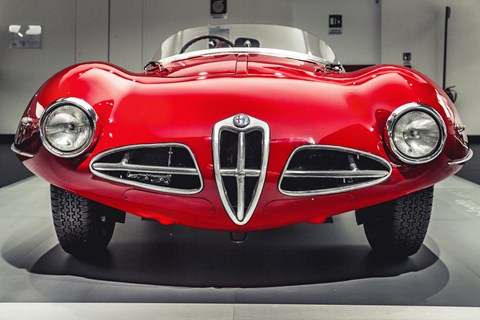
1952 Disco Volante
The product of a request from the US for an Alfa barchetta sports racer, the Disco Volante was loosely based on the 2000 saloon’s humble underpinnings. Very loosely… The engine was light alloy rather than iron and it rested in a labour-of-love tubular steel chassis. Turin’s still-sensational Superleggera body was an Italian take on 1950s America’s predilection for fins. Ultimately the Disco Volante was too far removed from efficient production realities to succeed and just five were built, four Spiders and a coupe.
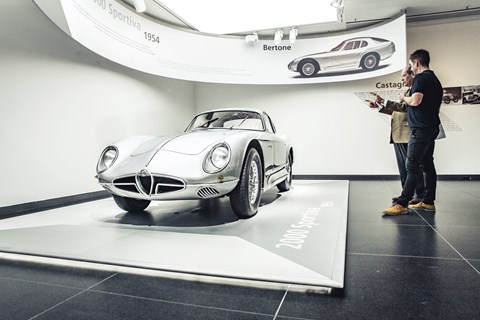
1954 2000 Sportiva
Essentially a concept car, only two 2000 Sportivas were built. Designed by Scaglione for Bertone in the early 1950s, it anticipated myriad future design trends including a small cabin with wraparound glazing and a curved front that blended into the sides of the car. The Sportiva’s delicate beauty is evident in numerous subsequent Alfas, including the 1950s Giulietta Sprint and Giulietta Sprint Speciale and the 8C, conceived more than half a century later.
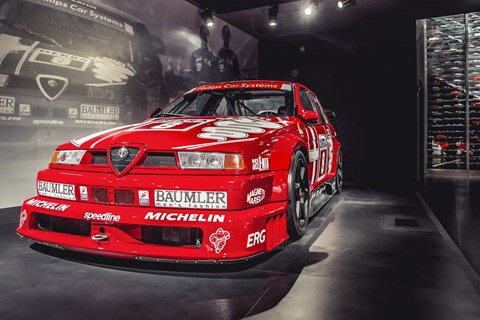
1993 155 V6 TI
The 155’s DTM title in 1993 remains one of motorsport’s great upsets, and such humiliation for Mercedes-Benz that it promptly developed an altogether more serious 500bhp V6 C-class in riposte. Based on the front-wheel-drive 155 production saloon, the much-modified racer interpreted the DTM rulebook with an Adrian Newey-esque eye for the just-legal exploitation of anything even resembling a loophole. The engine used the same bore spacing and alloy construction as the road car’s but went to town with dry- sump lubrication, lightweight internals and titanium inlet valves for a 12,000rpm rev ceiling. The car’s 420bhp found its way to the ground via race-bred four-wheel drive and had just 1100kg to shift. The 155 V6 TI won 12 of the ’93 seasons’ 20 races, and secured the title for Nicola Larini.
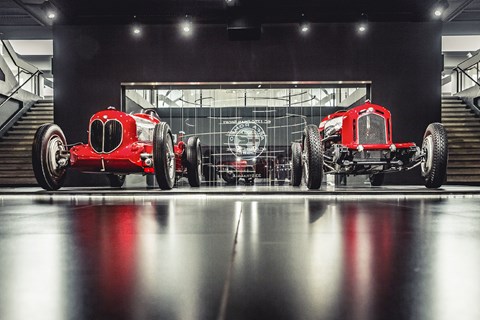
1933 Tipo A & ’35 Bimotore
Need more speed? Go for two engines. For the 1931 Formula Libre series Alfa created the Tipo A (right); two straight-six engines sitting side by side for a top speed north of 150mph. Alfa resurrected the concept with the ’35 Bimotore, only this time the engines were supercharged straight-eights; one in the nose, one in the tail. Tazio Nuvolari piloted his to a terminal speed of 226mph, earning himself a golden tortoise: ‘To the fastest man, the slowest animal.’
Read more CAR features